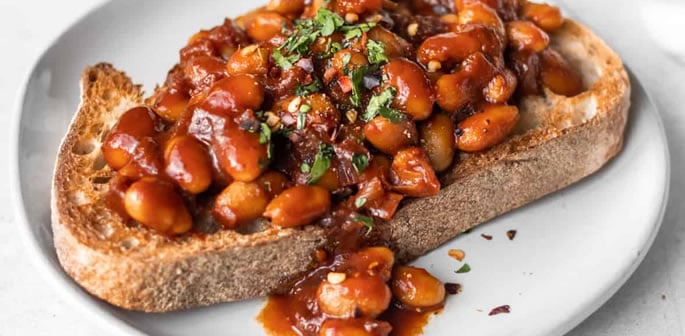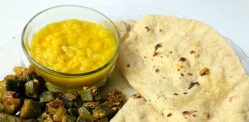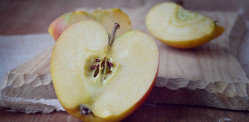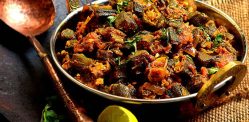“Although we can’t digest these materials, our gut bacteria can."
The resistance starch diet is a cheap and easy way to lose weight and it is backed by science.
A study found that supplementing the daily diets of overweight people with 40 grams of resistant starch improved their insulin resistance, boosted their gut microbiome and helped them lose weight.
And the best part is that resistant starch naturally occurs in most everyday staple foods like beans, lentils and wholegrain bread.
So how does this diet work?
All carbohydrates and sugars contain glucose but the difference lies in how your body processes them once swallowed.
Sugar is composed of two molecules so it is easily broken down, the glucose absorbing rapidly from your small intestine into your blood, leading to rapid blood sugar spikes.
When that glucose cannot be removed from the blood, the body stores it as fat.
Meanwhile, carbohydrates, including fibre and starch are constructed differently. Their glucose molecules are joined in long chains, with some easy to dismantle, others less so.
Simon Gaisford, a professor of pharmaceutics and microbiome expert at University College London, says:
“The more branched, cross-linked or tightly wrapped the carbohydrate, the harder it is for the body to break them down and utilise them for fuel.”
Simple starches are easily broken down and absorbed in your small intestine. But resistant starch is tightly bound, making it act more like fibre which cannot be broken down.
Instead, it passes into your lower intestine.
This has benefits if you are trying to control or lose weight.
Nutritional therapist Rhian Stephenson says:
“Studies have shown that resistant starch consumption can reduce postprandial glucose – the rise in blood sugar levels after eating – by 33%.”
She explains that this has a positive impact on our appetite, mood and energy.
“We want a sloping rise and fall in blood sugar, not a dramatic spike and subsequent crash.
“The slower, more measured release of carbohydrate into the blood helps us stay fuller for longer and feel better in general.”
With that said, we look at its benefits on gut health as well as some of the best foods.
Gut Health
The study highlighted that gut health in the subjects who took resistant starch also improved.
This is likely because of what happens in the next stage of its journey, inside your large intestine.
Gaisford says: “Although we can’t digest these materials, our gut bacteria can.
“They break it down to release glucose, but then they use that glucose for fuel, so we don’t get blood glucose spikes.
“Different types of bacteria produce different waste products from metabolism, so in effect, the bacteria in our gut turn something we would ordinarily waste into a myriad of useful compounds.”
Gaisford admitted the study was small but the science stacks up. But what about the best foods to have?
Beans on Toast
Stephenson says: “There are three types of naturally occurring resistant starch.”
Type one is resistant to digestion because it is trapped within the fibrous cell walls of the food itself. This form is found in beans, lentils and grains.
Beans on toast is an option but Stephenson highlighted the specifics to ensure health benefits.
“It’s all about the nuance here.”
“Homemade or more natural forms of baked beans, on high-quality toast like whole grain sourdough could be a great choice.
“Beans with lots of added sugar and thickeners like corn starch on ultra-processed bread would not confer the same benefits.”
Overnight Oats
Oats are among the cheapest items in supermarkets.
When left raw, they are a good source of resistant starch. However, the benefits fade once they are cooked.
To maximise resistant starch, make overnight oats using jumbo oats.
Stephenson suggests soaking two cups of oats in the same quantity of milk.
Add a teaspoon of vanilla extract, some mashed berries and a pinch of salt. Stir, and leave in the fridge overnight. In the morning, top with seeds.
Banana & Almond Butter
Cheap, sweet and naturally pre-wrapped, banana is one of the easiest snacks around.
It is also high in ‘type two’ resistant starches, indigestible because they are so compact.
But the catch is to eat them while they are still relatively green. As bananas ripen and yellow, the resistant starch turns into simple sugars.
Slice before they get to this stage and top with almond butter.
Potato Salad
Stephenson explains that there is one final form of naturally occurring resistant starch:
“Retrograde resistant starch forms when certain starches have been cooked and cooled.”
When cooked pasta, potatoes or rice is cooled, some of the starches turn into resistant ones.
In 2013, American research concluded that a baked potato contained 3.6 grams of resistant starch per 100g and a boiled potato 2.4g. But if you chilled either one, that figure rose to 4.3g.
Therefore, not only is potato salad a good way to stretch leftovers but it is a great way to enjoy potatoes while reducing their glycemic load.
Roughly chop some leftover, cooled boiled potatoes. Add some boiled eggs, spring onions, celery, tomatoes and cucumber.
Dress with olive oil, Dijon mustard, apple cider vinegar, a squeeze of lemon and chopped dill and parsley. Toss and enjoy.
Bread from the Freezer
Dr Emily Leeming, a scientific researcher at King’s College London, says:
“The same effect happens with fresh bread kept in the freezer.”
As it freezes, starches turn into resistant starch.
So keep some bread in the freezer, not just to save money but also to boost your health.
Microwaved Rice with Daal
In 2015, Sri Lankan researchers found that white rice, boiled in water with a teaspoon of coconut oil, drained, then left in the fridge for 12 hours contained at least 10 times the resistant starch to that conventionally prepared.
Reheating it had no adverse effect on these boosted properties.
In fact, other studies have suggested that microwave reheating can slow the pace of starch digestion.
Lentils and chickpeas are one of the best sources of resistant starch.
Nearly half of the starch in raw legumes is resistant to digestion.
A Florida State University study found that working the resistant starch into your diet via pulses “fosters the growth of beneficial gut bacteria and significantly enhances the production of short-chain fatty acids in the colon”.
Daal is very cheap and typically found either tinned or in dried form.
How Much is too Much?
Before embarking on the resistance starch diet, there are a few things to consider.
Participants in the new study were fed 40g of resistant starch a day in powder form.
Dr Leeming says:
“It’s highly unlikely you would eat 40g of resistant starch without taking a supplement.”
For reference, 100g of cooked beans is likely to contain between 1-5g of resistant starch. The same quantity of cooled and then reheated white rice will serve up to around 1.65g.
But in any case, it is best not to just focus on your resistant starch intake.
The more useful goal would be to increase your daily fibre intake, with resistant starches counting towards that target.
Many of us fail to reach the minimum 30g daily intake even though fibre reduces the risk of heart disease, stroke, type two diabetes and bowel cancer as well as helping you feel fuller for longer.
Considering how to increase the resistant starch of foods that traditionally have less fibre and more of an effect on blood sugar can be a great way to adjust your nutrition and ultimately, lose weight.




































































